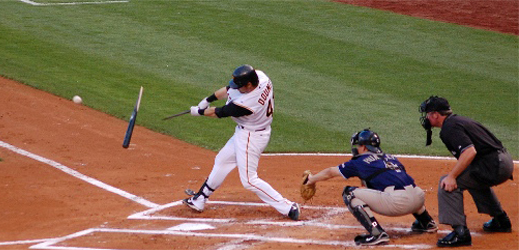
Scientific American
Batter Up: Shattering Sticks Create Peril in MLB Ballparks:Baseball officials are noticing more and more broken bats–and injuries. Where lies the blame.
CLICK HERE TO READ THE STORY ON SCIENTIFIC AMERICAN
Witness the following: On June 24, home plate umpire Brian O’Nora was hospitalized after the broken barrel of a bat hit him on the head during a game between the Colorado Rockies and Kansas City Royals. He suffered a mild concussion.
On April 25, the barrel of a maple bat used by Colorado Rockies first baseman Todd Helton flew into the stands in Dodger Stadium in Los Angeles, hitting Susan Rhodes of Sherman Oaks, Calif., and breaking her jaw. Ten days earlier, Pittsburgh Pirates hitting coach Don Long was struck in the face by a shard from Pirate’s center fielder Nate McLouth’s shattered bat during a game at the Dodger’s park.
As Major League Baseball prepares for tonight’s Home Run Derby and tomorrow night’s All-Star Game at Yankee Stadium in New York City, players and fans might be well-advised to keep a close eye not just on the ball, but on the bats as well. This season, an alarming number of bats have been exploding on contact with pitches—shooting sharp timber projectiles onto the field and into the stands, where they have struck coaches, fans, players and umpires—prompting players and management to call for testing that will get to the root of the problem.
Hard statistics are hard to come by. The Elias Sports Bureau, the official statistics keeper for Major League Baseball, says it doesn’t keep track of such incidents. The league is aware that the number of broken bats is up this season, but, says Patrick Courtney, a Major League Baseball spokesman, “I do not have any statistical data that I can share at this point.”
The league is concerned. “We have to find out why these bats are breaking,” Courtney says. “We’ve never seen issues like this where [pieces of] bats were flying out into the outfield and into the stands. We need to find out what has changed to cause the bats to do this.”
One theory blames the increased use of maple wood instead of more traditional ash and the players’ preference for bats with thinner handles. Maple bats came into fashion about a decade ago, when all-time home run leader Barry Bonds began using them. “As more and more players used it,” Courtney says, “the demand went up and the approved bat manufacturers tried to respond to the demand.” That, despite the fact that a 2005 study by James Sherwood, director of the University of Massachusetts Lowell Baseball Research Center, found no evidence that a baseball hit by a maple bat flew farther than a baseball hit by an ash bat.
When it comes to broken bats, however, players say they are well aware of the difference between the way maple and ash bats perform under stress. “A maple bat can have a crack in it that you don’t know about, and all of a sudden you hit a ball on the barrel and it explodes,” Houston Astros first baseman Lance Berkman told MLB.com recently. “An ash bat is true. You can always tell if there’s something wrong with it.”
The maple may not be the only cause for all of the busted bats. Players get to the major leagues after years in high school and college swinging aluminum bats that have thin handles. “With aluminum bats you can make the handles much thinner because the material is so much stronger,” says Dave Peters, an engineering professor at Washington University in Saint Louis’s School of Engineering and Applied Science. Players tend to order wooden bats whose handles are shaved to the shape of aluminum bats. “That makes the handle too skinny.”
Jim Anderson, director of sales at maple bat maker MaxBat in Brooten, Minn., agrees, saying it is “absolutely impossible” to replicate the look and feel of an aluminum bat in a wooden bat without making it more fragile. Increasing the diameter of the bat handle just few millimeters can increase bat strength without being too noticeable to the player; the trick is convincing young players that they can succeed with a more stable bat, he says.
Major League Baseball has a 16-member Safety and Health Advisory Committee consisting of management and players working with bat manufacturers and experts in the field, including Anderson, conducting laboratory tests of bats and gathering information about protective measures. They’re also looking into whether Major League ballparks have put fans in more danger by designing seats that are closer to the field. The league expects the committee to report its findings by the end of the season.